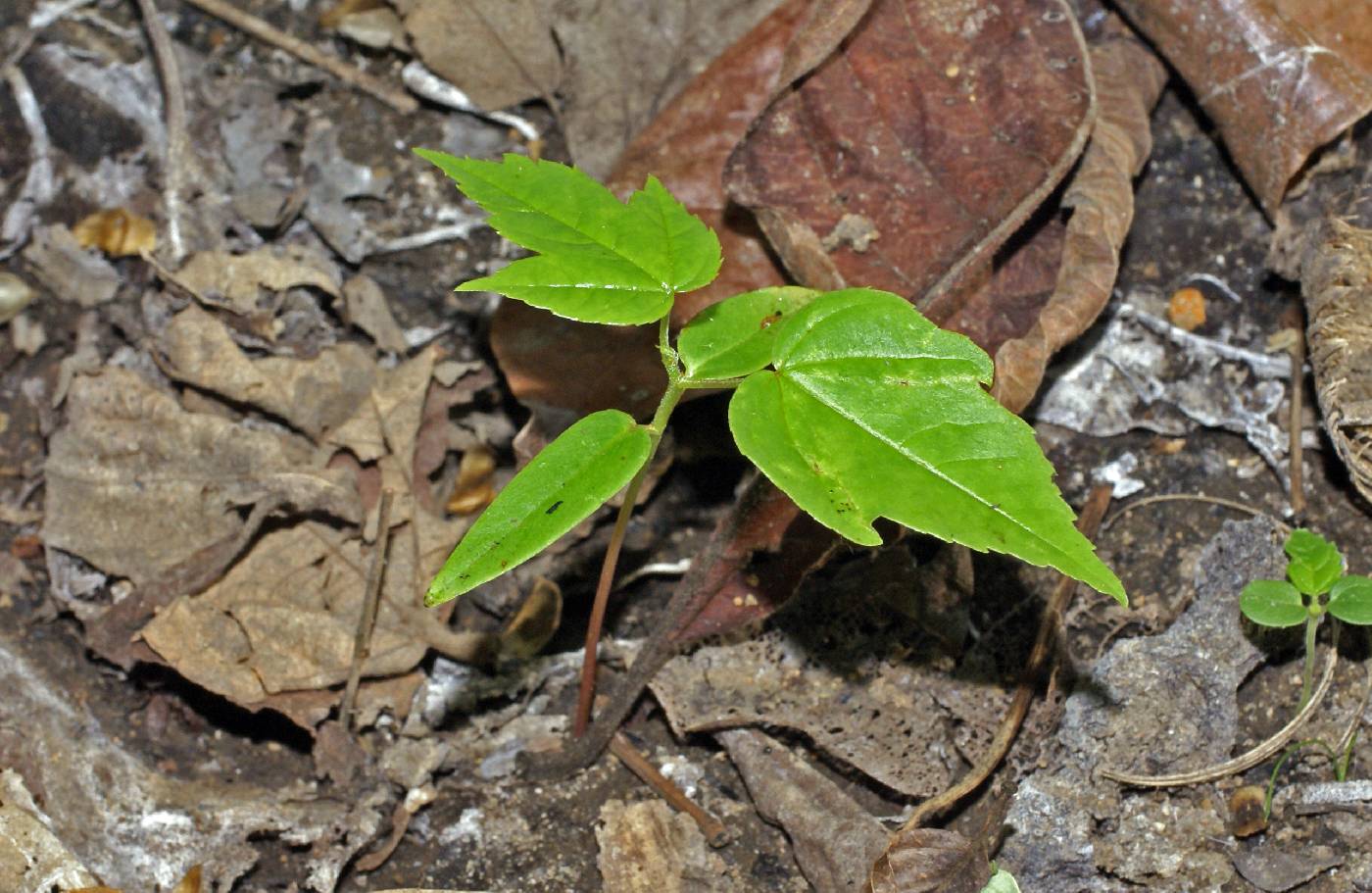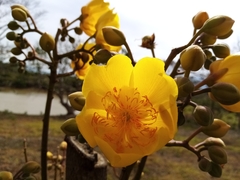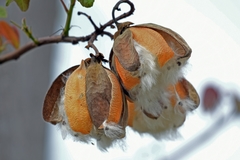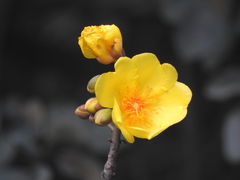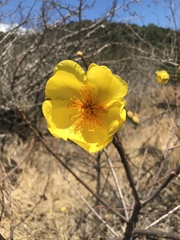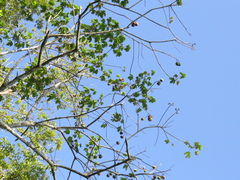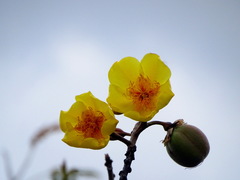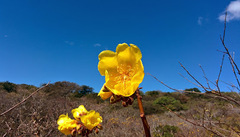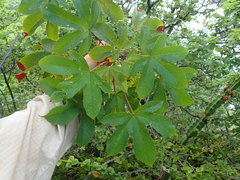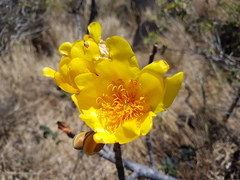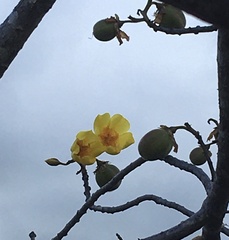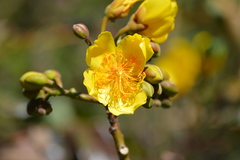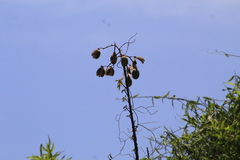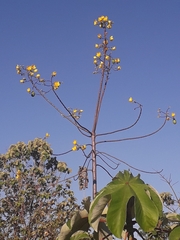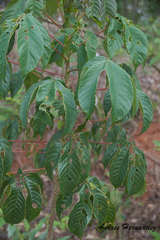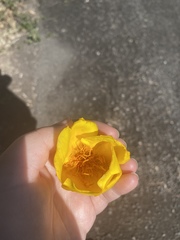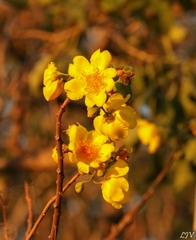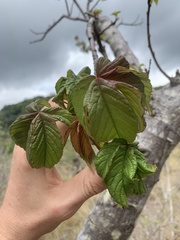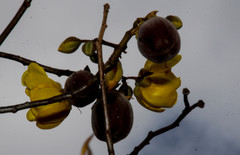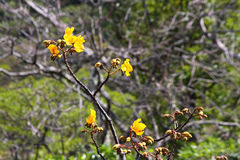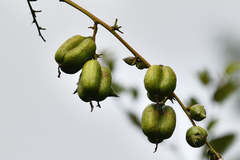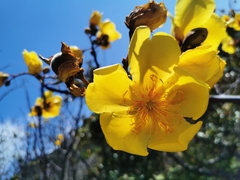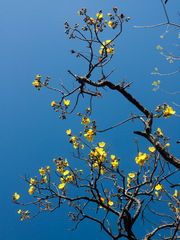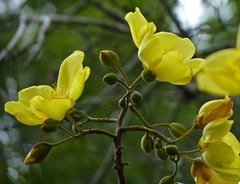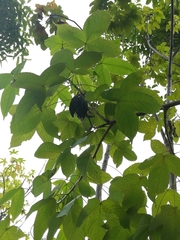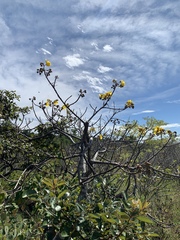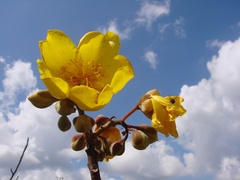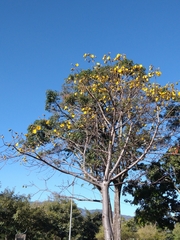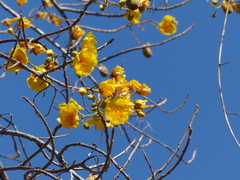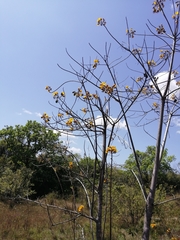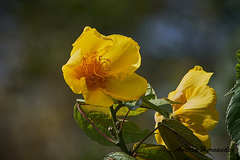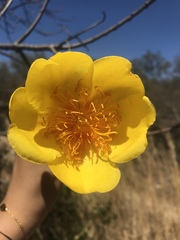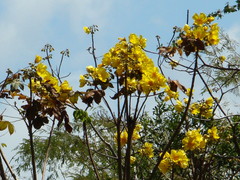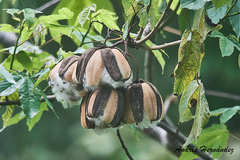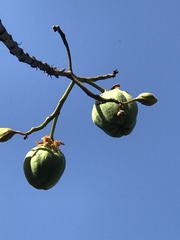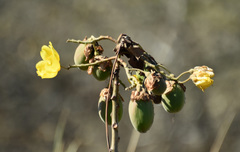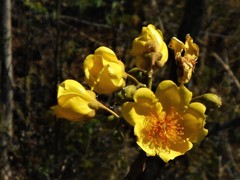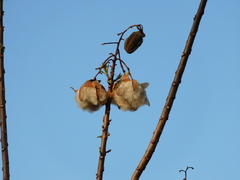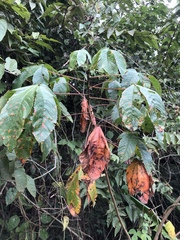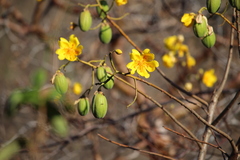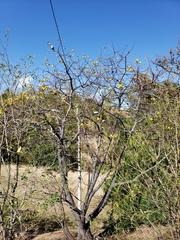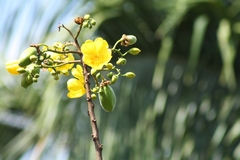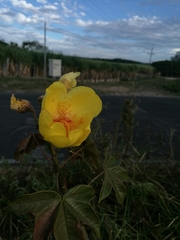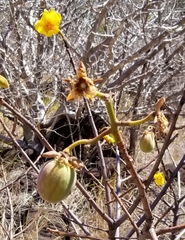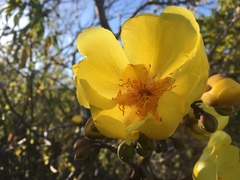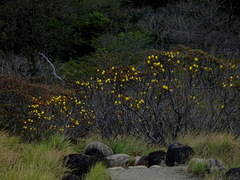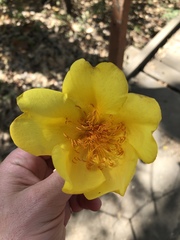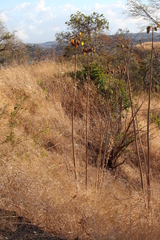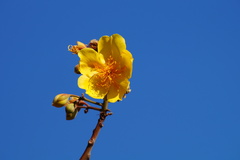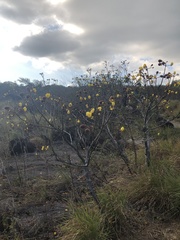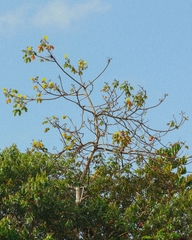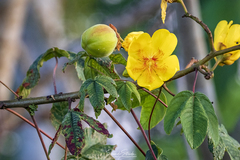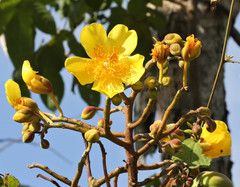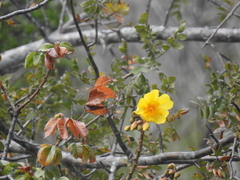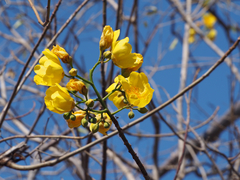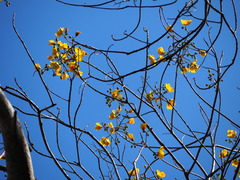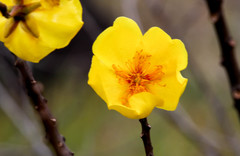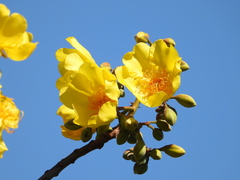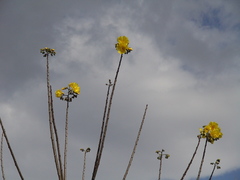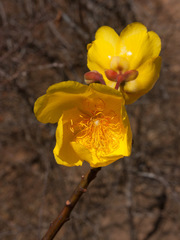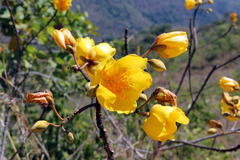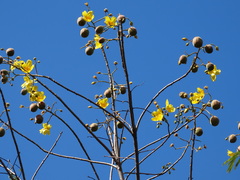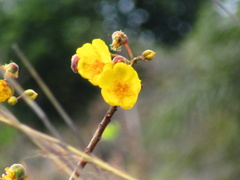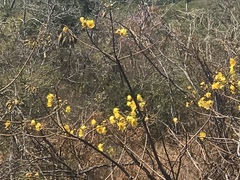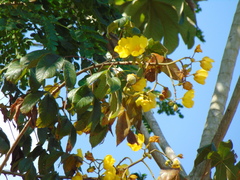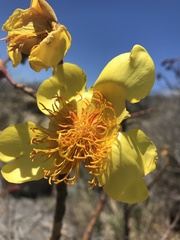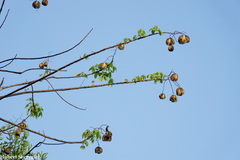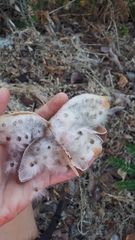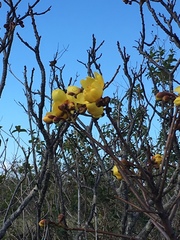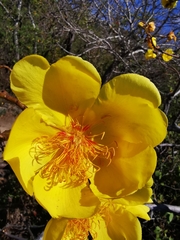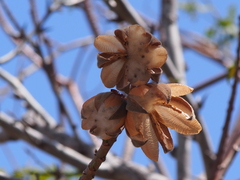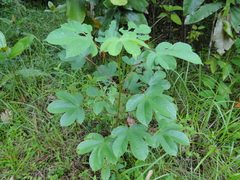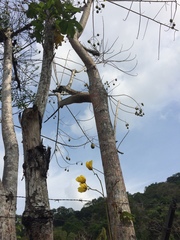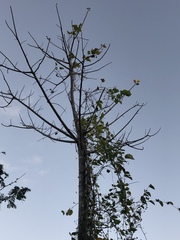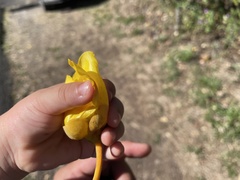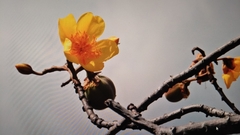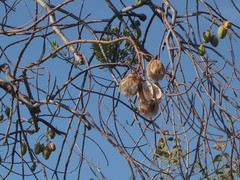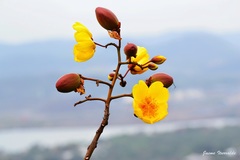

|
|
|
|
Family: Bixaceae
Silk-Cottontree, more... (es: palo barril, rosa amarilla, madera de pasta, carne de perro, Poro poro, poro-poro)
[Maximilianea vitifolia (Willd.) Krug & Urban] |
Description: A small tree, usually no more than 7 meters tall, usually with a leaning trunk and irregular branching. Crown is small, irregular, often with few leaves. The leaves are star-shaped, with pointed lobes, like the sweetgum Liquidambar) of North America, and toothed. Petioles are usually reddish, at least in part. Reproduction: Flowers are large, bright yellow, with many yellow or orange stamen, very conspicuous during the December-January flowering period. Many trees are leafless when flowers are produced, but others have some leaves. Individual trees produce few flowers, and small plants no more than 2 meters tall can produce one or two flowers. Fruits are green pods filled with tiny seeds that have light fluff for wind transport. Distribution: A widespread and common tree of pastures, farms, towns, and roadsides, throughout Panama. Never in the forest, even in natural tree-fall clearings, so it seldom appears in tree plots (which are nearly always in the forest). Apparently resistant to fire, because it is common in fields that burn regularly. Similar Species: Most often noticed when it produces the spectacular yellow flowers, but even without, the star-shaped, lobed leaves should be easy to learn. The leaves resemble those of LK ceibpe Ceiba pentandra, LK2 or of the genus LK pochse Pachira, LK2 both species in the family Bombacaceae, but the Bombacaceae leaves are made up of separate leaflets, whereas Cochlospermum leaves are simple, with pointed lobes. Fruits of Cochlopermum also resemble the fruits of those Bombacaceae, and indeed the two familes are closely related. Uses: The poro-poro grows readily from cut branches stuck in the ground, and it is sometimes planted as an ornamental. Descripción: Árbol de 5 a 12 m de alto. Copa pequeña y abierta. Tronco ramificado a baja altura. Corteza exterior blanca o gris, a veces con líneas verdes. Corteza interior de color amarillento, a veces exuda una savia anaranjada o amarillenta. Ramitas terminales de color rojizo. Hojas simples y palmatilobuladas, alternas, de 12-15 cm de ancho, lóbulos con ápice acuminado y bordes dentados. Láminas foliares con base cordada. Pecíolo de 8-20 cm de largo, a veces con una coloración rojiza. Flores grandes y de color amarillo intenso. Frutos en cápsulas globosas, de 7-10 cm de largo, verdes, tornándose negros y dehiscentes en cinco valvas al madurar. Semillas envueltas en una capa de pelos algodonosos. Datos Ecológicos: La especie crece a bajas elevaciones, en lugares secos o húmedos de todo el país. Común y fácil de observar a orillas de carreteras, pastizales y áreas abiertas y soleadas. Deja caer sus hojas durante la estación seca, pero las repone a inicios de la estación lluviosa. Florece y fructifica entre diciembre y abril, cuando el árbol carece de hojas. Especies Parecidas: A menudo se confunde con plantas juveniles de LK pse1se Pseudobombax septenatum LK2 , pero en P. septenatum las hojas son digitadas y los folíolos tienen los bordes enteros. Usos: La madera es empleada para pulpa de papel. Los pelos algodonosos del fruto se utilizan para rellenar almohadas y colchones. La fibra de la corteza se emplea para fabricar cuerdas para amarrar. Las hojas y las flores se utilizan como forraje para el ganado. La corteza, hojas, flores y raíces se usan en la medicina tradicional, también para preparar un remedio contra las mordeduras de las serpientes. La especie tiene uso ornamental por sus hermosas flores de color amarillo intenso. Brazilian rose, Poro-poro Tree, 3-12 m tall, mostly to 10 cm dbh (sometimes to 70 cm dbh elsewhere); wood very soft; branches few; branchlets densely pubescent, becoming sparsely so in age. Stipules subulate, small, caducous; petioles to 30 cm long; blades usually palmately 5-lobed, cordate at base, mostly 12-25 cm wide, glabrous above, puberulent below, the lobes acute to acuminate, the margins usually crenate. Flowers yellow, pedicellate, the inflorescence branches recurved near apex; sepals 4 or 5, unequal, the 2 outer sepals ovate to oblong-obovate, usually rounded at apex, 12-18 mm long, 7-9 mm wide, the 3 inner sepals mostly obovate to subrotund, rounded at apex, 20-22 mm long, 16-20 mm wide; petals 4 or 5, obovate, 5-6 cm long, often emarginate at apex; stamens yellow, numerous, the outer ones longer, curved inward near apex; anthers slender, somewhat curved; pollen dehiscing from a single apical pore; style longer than stamens, at first +/- erect, later recurved and about equaling height of anthers, the apical part somewhat hooked; stigma simple. Capsules +/- obovoid, 5-valved, to 8 cm long; seeds reniform, 4-5 mm long, bearing many cottonlike fibers. Croat 7690. Probably once common, now rare; known only from a few places along the shore, especially the north edge of Orchid Island. Flowers throughout the dry season (December to April). The fruits mature in late dry and early rainy seasons (March to July). Leaves fall throughout most of the dry season. The species can be recognized at once by the large yellow flower with numerous stamens and by the palmately lobed leaf. A large pollinator, such as a bat, bird, or large bee, would be the most effective for this large flower with protruding style. Primary pollinators in Costa Rica are large bees, principally in the families Anthophoridae and Xylocopidae (G. Frankie, pers. comm.). Capsules open broadly, but the wind-dispersed seeds leave only a few at a time, the rest being held by the outer capsule valves, which curve sharply inward and hold the cottony mass of seeds. Mexico to northern South America. In Panama, a characteristic component of tropical dry forest (Holdridge & Budowski, 1956) and a common invader (Holdridge, 1970); known from tropical moist forest in the Canal Zone, Herrera, Panama, and Darién, from premontane moist forest in the Canal Zone, Los Santos, and Coclé, and from tropical wet forest in Panama (Cerro Campana); cultivated in San Blas (Duke, 1968). |

